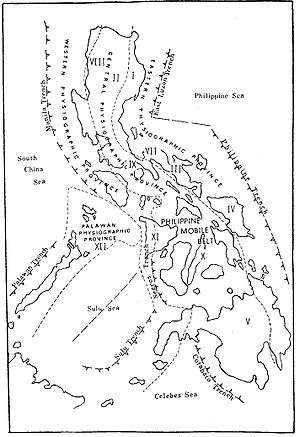Philippine Mobile Belt

The Philippine Mobile Belt is a complex portion of the tectonic boundary between the Eurasian Plate and the Philippine Sea Plate, comprising most of the country of the Philippines. It includes two subduction zones, the Manila Trench to the west and the Philippine Trench to the east, as well as the Philippine Fault System. Within the Belt, a number of crustal blocks or microplates which have been shorn off the adjoining major plates are undergoing massive deformation.[1]
Most segments of the Philippines, including northern Luzon, are part of the Philippine Mobile Belt, which is bounded by the Philippine Sea Plate to the east, the Molucca Sea Collision Zone to the south, Sunda Plate to the southwest, and the South China Sea Basin to the west and north-west.[2] To the north it ends in eastern Taiwan, the zone of active collision between the North Luzon Trough portion of the Luzon Volcanic Arc and South China.[3] The Philippine Mobile Belt has also been called the Philippine Microplate[4] and the Taiwan-Luzon-Mindoro Belt.[5]
Palawan and Sulu
Although they are part of the Republic of the Philippines, Palawan with the Calamian Islands, plus the Sulu Archipelago with the Zamboanga Peninsula of western Mindanao, are the tops of two protruding north-eastern arms of the Sunda Plate. They are not part of the Philippine Mobile Belt but are in collision with it. The Sulu Trench marks the boundary of the Sulu micro-block with the Sulu Sea basin and the Palawan micro-block. The inactive Palawan Trench marks the subduction boundary between the Palawan microblock and the Spratly Islands plateau of the South China Sea basin.[6] The Palawan/Calamian arm was also known in 1981 as the Palawan block and Palawan microcontinent,[7] and in 1989 as the Palawan Micro-Block.[8]
Boundaries
The Philippine Mobile Belt is bounded on the west by the Manila Trench and its associates the Negros Trench and the Cotabato Trench, which subducts the Sunda Plate under the Philippine Mobile Belt. To the east is the Philippine Trench and its northern associate, the East Luzon Trench which subducts Philippine Sea Plate the Philippine Mobile Belt.[9] The continuity of the Philippine-East Luzon Trench is interrupted and displaced by Benham Plateau on the Philippine Sea Plate,[10] which collided and is still colliding with the Sierra Madre of eastern Luzon.[11]
To the north the Philippine Mobile Belt ends in Taiwan, where accreted portions of the Luzon Arc and Luzon forearc form the eastern Coastal Range and the inland Longitudinal Valley of Taiwan, respectively.[12]
To the south the Philippine Mobile Belt terminates in the Molucca Sea Collision Zone, which is itself part of the elongated zone of convergence extending north through the Philippines into Taiwan. Within the Molucca Sea Collision Zone, the Molucca Sea Plate has been totally subsumed by the arc-arc collision of the Halmahera Arc and the Sangihe Arc of eastern Indonesia.[13]
Luzon
The island of Luzon is bisected by the braided N-S trending Philippine Fault System.[14] Luzon is not bisected E-W, and illustrations showing anything similar are erroneous. Northern Luzon is integral with southern Luzon. Any suggestion that Northern Luzon is not part of the Philippine Mobile Belt is not borne out by the detailed fault mapping of Pinet and Stephan (1989),[15] and others. A common tectonic plate illustration for the Philippines[16] is incorrect in this regard.
Collage of 17 principal blocks
The composition of the Philippine Mobile Belt is generally interpreted as a collage of a large variety of blocks or terrane of diverse origin amalgamated before collision with the Eurasian margin.[17] Seven principal blocks have been identified in Luzon: the Sierra Madre Oriental, Angat, Zambales, Central Cordillera of Luzon, Bicol and Catanduanes Island blocks. In the Central Philippines four principal blocks have been identified: Panay, Mindoro, Cebu and Bohol. In Mindanao six principal blocks have been identified: Pacific Cordillera, Surigao, Pujada peninsular, Central Cordillera of Mindanao, Daguma range and Zamboanga.[18]
See also
References
- ↑ Modeling the Philippine Mobile Belt: Tectonic blocks in a deforming plate boundary zone Galgana, G. A.; Hamburger, M. W.; McCaffrey, R.; Bacolcol, T. C.; Aurelio, M. A. American Geophysical Union, Fall Meeting 2007, abstract #G21C-0670
- ↑ Rangin and Pubellier (1990) in Tectonics of Circum-Pacific Continental Margins ISBN 90-6764-132-4 p140 ff
- ↑ Clift, Schouten and Draut (2003) in Intra-Oceanic Subduction Systems: Tectonic and Magmatic Processes, ISBN 1-86239-147-5 p84-86
- ↑ Hashimoto, M, ed., (1981) Accretion Tectonics in the Circum-Pacific Regions, ISBN 90-277-1561-0 p302
- ↑ Nicolas Pinet and Jean Francois Stephan (1989) in Tectonics of Circum-Pacific Continental Margins ISBN 90-6764-132-4 p165
- ↑ Rangin and Pubellier (1990) in Tectonics of Circum-Pacific Continental Margins ISBN 90-6764-132-4 p148
- ↑ Hashimoto, M, ed., (1981) Accretion Tectonics in the Circum-Pacific Regions, ISBN 90-277-1561-0 p303
- ↑ Nicolas Pinet and Jean Francois Stephan (1989) in Tectonics of Circum-Pacific Continental Margins ISBN 90-6764-132-4 p167 Fig 1, p175, p177
- ↑ Hashimoto, M, ed., (1981) Accretion Tectonics in the Circum-Pacific Regions, ISBN 90-277-1561-0 p299
- ↑ Deschamps and Lallemand (2003) in Intra-Oceanic Subduction Systems: Tectonic and Magmatic Processes ISBN 1-86239-147-5 p165
- ↑ Rangin and Pubellier (1990) in Tectonics of Circum-Pacific Continental Margins ISBN 90-6764-132-4, p149
- ↑ Clift, Schouten and Draut (2003) in Intra-Oceanic Subduction Systems: Tectonic and Magmatic Processes, ISBN 1-86239-147-5 p86
- ↑ Macpherson, Forde, Hall and Thirlwall (2003) in Intra-Oceanic Subduction Systems: Tectonic and Magmatic Processes, ISBN 1-86239-147-5 p208
- ↑ Nicolas Pinet and Jean Francois Stephan (1989) in Tectonics of Circum-Pacific Continental Margins ISBN 90-6764-132-4 p170
- ↑ Nicolas Pinet and Jean Francois Stephan (1989) in Tectonics of Circum-Pacific Continental Margins ISBN 90-6764-132-4 p167 Fig 1
- ↑ File:Philippine Sea plate.JPG
- ↑ Rangin and Pubellier (1990) in Tectonics of Circum-Pacific Continental Margins ISBN 90-6764-132-4 p149
- ↑ Rangin and Pubellier (1990) in Tectonics of Circum-Pacific Continental Margins ISBN 90-6764-132-4 p148 fig 4

